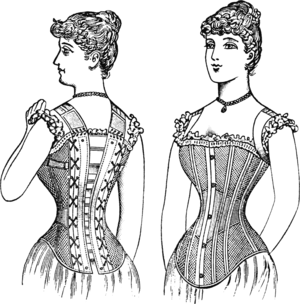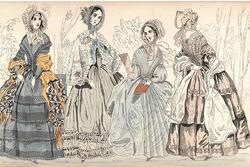Corset On, Corset Off
For most of my life, my fashion sense has been dictated more by what I don’t want to wear than what I do want to wear. Socks with seams? Nope. Tight jeans? No way. Itchy sweaters? Out of the question! I feel almost nothing towards clothes, and when I do feel anything, it is usually frustration at tedious trips to the mall and or the seamstress shop. Sure, I enjoy looking “good.” But I have never really had any idea what “good” actually means.
When I first received my assignment to write about fashion and feminism, I drew a blank. How could I write about a topic that seemed so far away from my own interests? After several unproductive brainstorming sessions, I followed the hallowed path of countless desperate knowledge seekers: I borrowed a friend’s book on the subject. Fashion: A Visual History from Regency and Romance to Retro and Revolution by NJ Stevenson, covers the nearly 200-year evolution of modern fashion over 271 thick, glossy pages. Taken by its gorgeous illustrations and pictures, I put on my most glamorous thinking cap and dove in.
For the first time in my life, I spent a large chunk of my time immersed in the world of Fashion. Quotes from frank and fashionable ladies jumped out of the pages. “A girl should be two things: classy and fabulous,” boasted pioneering designer Coco Chanel, while the much more cynical Wallis Simpson proclaimed, “A woman can never be too rich or too thin.” A committed history buff, I discovered fascinating tidbits of trivia. Suffragette colors were purple, green, and white! Salvador Dali dabbled in fashion! The topless swimsuit is a real thing!
Yet there was one entity that was constantly hovering over my journey through fashion history: the corset.
I don’t think there has ever been symbol for the restrictive expectations that have been placed on women over the years as damning as the corset. It is, quite literally, a cage that nineteenth- century women were required to wear on their torsos in order to be considered presentable, squeezing them so tightly that they couldn’t breathe! Abandoned during the early 1800s as part of a trend to move away from pre-French Revolution extravagance, corsets came back in vogue in the 1820s, and as Stevenson writes, “The female form was not to achieve its natural state again for nearly a century.” Even after its disappearance in during the sparse World War II era, it returned yet again in the 1950s before going away, and then coming back again with the designs of 1980s Vivienne Westwood, a vibrant punk visionary who reclaimed the corset for women as an edgy and ostentatious statement.
Reading about the ups and downs of the corset gave me the insight into the importance of fashion which I had always resisted accepting. The road to women’s liberation has not been a straight-line, but, like the corset, an escalating series of broad, bumpy, small, and slight twists. We should not despair when there are setbacks to the process of achieving our full rights; we must try our best be resilient. For every victory in the court room, there will be push back and degradation in the streets. For every woman’s advancement to a place of power and influence, there will be sexism and bitter attacks. Too many people see fashion as frivolity, and look down on others, women especially, for enjoying clothes. Not too long ago, I was one of those people. Like a classic bigot, I resented what I did not understand. Now, I am trying to upgrade my views—though I’m not quite ready to do the same to my wardrobe. I hope that will change someday. To participate in fashion is to participate in the tide of history, to take pride in being shaped by the world and shape it right back.
This piece was written as part of JWA’s Rising Voices Fellowship.








Knowing what to wear is contingent on knowing what not to wear, and it seems that women nowadays have lost track of a basic human trait called modesty. For Jewish women, modesty is a very affirmative act of love and justice. It gives a sense of dignity and self-respect, and it respects the boundaries of others, too.
As a costumed historic (1806) interpreter, I'd like to share something you may find surprising, I know I did. When a corset (with boning) is adjusted well, it can not only be comfortable, but supportive. You know those "core" muscles we are supposed to develop? A corset supports your core while those muscles are in training (or not). I find I can sit or stand for long hours without tiring my back.
You are so incredibly inspiring. This came out so well!!!